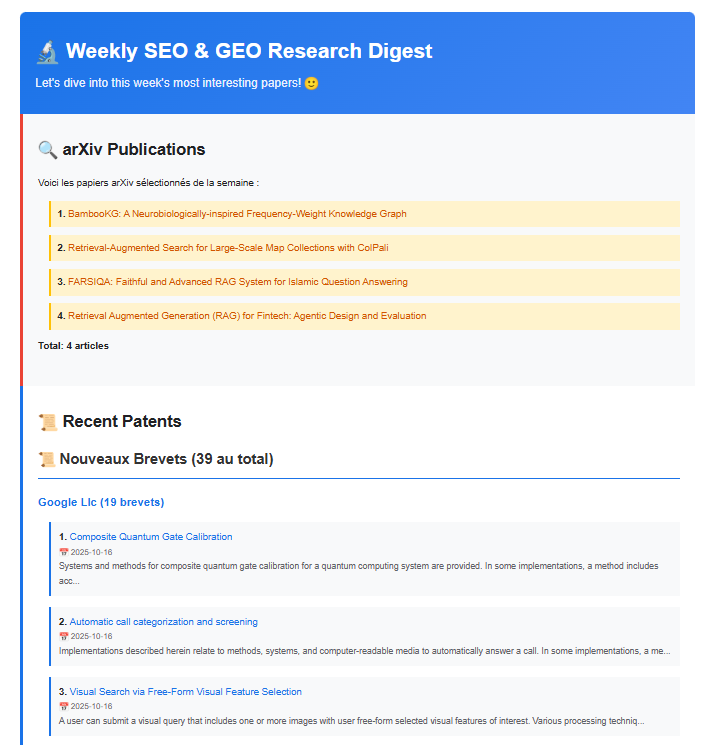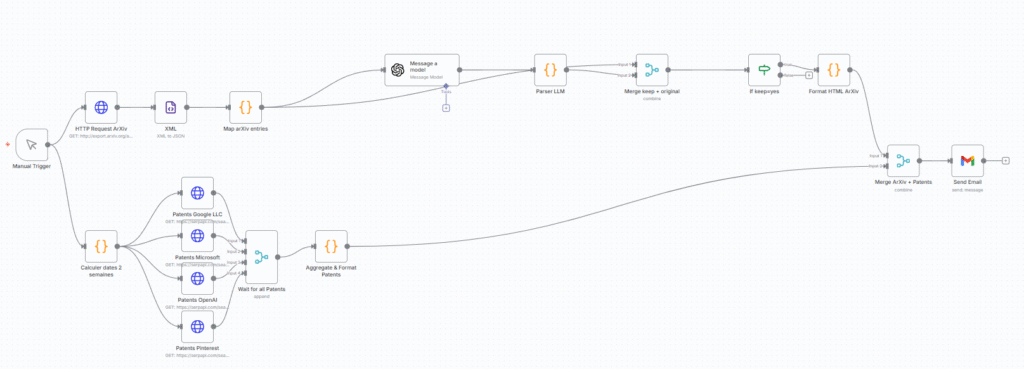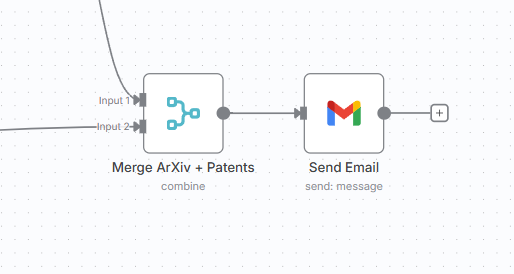How I Built an Automated Weekly SEO & GEO Newsletter Aggregating Research Papers & Patents

Why Research Papers and Patents Are Your Secret Weapon
Here’s the thing: if you want to actually understand how search engines, LLMs, and chatbots work, you can’t rely on Medium articles and LinkedIn carousels. That’s the surface level.
The real game? It’s in the patents and academic papers.
I’m obsessed with arXiv publications and Google Patents for one simple reason : they show you exactly how the people building these systems think. When Microsoft, Google, OpenAI, or Pinterest file a patent, they’re literally showing their hand. Same with research papers: they’re peer-reviewed insights into the latest breakthroughs in information retrieval, neural networks, and AI search.
If you’re trying to manipulate search rankings, understand AI Overviews, or figure out how LLMs will impact your digital strategy, you need to know what’s actually happening under the hood. Not the marketing narrative. Not the Linkedin hype. The actual technology.
So yeah, I spend a lot of time reading this stuff. And after doing it for hundreds of hours, I realized: why not automate the collection and delivery of the most relevant papers and patents?
That’s what this automation does.

Your Weekly Research Digest — Delivered to Your Inbox
Interested in receiving this weekly compilation yourself? You can be part of this automation. Every Monday morning, you’ll get a curated email with the most interesting research papers from arXiv and recent patents from Google, Microsoft, OpenAI, and Pinterest. All relevant to SEO, GEO, and search technology.
How the Automation Works (High-Level Overview)
I built this using n8n (a workflow automation platform), and here’s roughly how the pieces fit together:
Step 1: Calculate the Time Window
When the automation triggers, it first calculates a 2-week lookback window. This ensures we’re always grabbing the most recent papers and patents without too much overlap from previous weeks. We’re looking for papers published in the last 14 days.
Step 2: Fetch arXiv Papers

Next up, we hit the arXiv API to grab all recent papers. We’re specifically looking for papers related to search, information retrieval, NLP, and machine learning … basically anything that could impact how search engines or LLMs function.
But we don’t just grab any paper. The automation sends each paper to an LLM with a prompt asking, « Is this relevant to SEO/GEO/Search? » The LLM reads the abstract and makes a call: keep it or discard it.
This filters out the noise automatically. We only keep papers that are actually relevant to our domain.
Step 3: Fetch Patents from Tech Giants

While the arXiv papers are coming in, the automation runs four separate patent queries in parallel using the SerpAPI:
- Google LLC patents (15 most recent)
- Microsoft patents (15 most recent)
- OpenAI patents (5 most recent)
- Pinterest patents (2 most recent)
Each query looks back 2 weeks to grab the newest filings. We’re filtering by language (English, French, Spanish, German, etc.) to avoid languages I cannot read XD
Step 4: Aggregate & Format Patents
Once all patent queries return, we merge them and apply some intelligent filtering:
- Filter by approved companies only (Google, Microsoft, OpenAI, Pinterest)
- Remove non-Western languages that would be harder to process
- Group patents by company
- Format everything into clean HTML with links, titles, publication dates, and snippets
Step 5: Merge & Combine Everything
At this point, we have two streams: arXiv papers and formatted patents. These get merged together into a single pipeline.
Step 6: Generate Beautiful HTML Email
All of this gets compiled into a beautifully formatted HTML email. The template includes:
- A header with the week’s digest title
- An arXiv section with all relevant papers and their links
- A Patents section grouped by company, showing the most recent filings
- A summary box showing the total count of papers and patents
Step 7: Send It Out

Finally, the Gmail API sends the email to a predefined list of recipients. I’ll try to do it every monday morning but since it’s a manual trigger (for convenient purposes) I hope I’ll not forget to send it 😅
What You Actually Get in Your Inbox
When you receive the email, here’s what you’ll see:
🔍 arXiv Publications
A curated list of research papers that are actually relevant to your domain. We’re talking about papers on:
- Large language models and how they retrieve information
- AI Overviews / Mode and generative search
- Ranking algorithms and relevance
- Neural information retrieval
- And anything else that could impact your strategy
Each entry includes the title, link to the full paper, authors, and a brief description.
📜 Recent Patents
Patents from the big four (Google, Microsoft, OpenAI, Pinterest) grouped by company, showing:
- Patent title
- Direct link to the patent on Google Patents
- Publication date
- A snippet describing what the patent covers
📊 Summary Stats
A quick count of how many papers and patents made the cut that week.
The Technical Stack (For the Curious)
If you’re wondering what powers this:
- n8n – workflow orchestration and automation engine
- arXiv API – accessing research papers
- SerpAPI – scraping patent data from Google Patents
- Open Ai (via API) – filtering papers for relevance with LLM-powered intelligence
- Gmail API – sending emails
- JavaScript (n8n Code nodes) – data transformation and filtering logic
The Bottom Line
If understanding how search and AI actually work is important to your business (and if you’re reading this, it probably is), then staying updated on academic research and patent filings isn’t optional. It’s foundational.
Happy researching. 🚀

Ian Sorin is an SEO consultant at Empirik, a digital marketing agency based in Lyon, France. He’s increasingly automating time-consuming daily tasks but he’s careful never to fall into the « 100% automated » trap where human judgment disappears entirely. Because the point of automation isn’t to remove humans from the equation; it’s to remove the busywork so humans can focus on strategy and insights. Passionate about understanding how search engines truly work, he builds tools to automate analysis, runs experiments on his own projects, and constantly digs into the numbers to uncover new growth opportunities.





